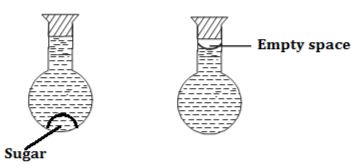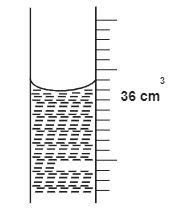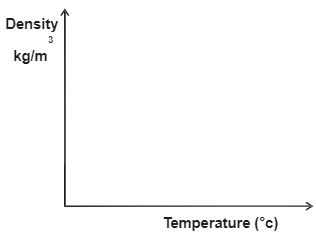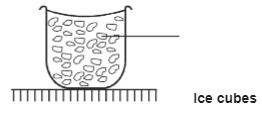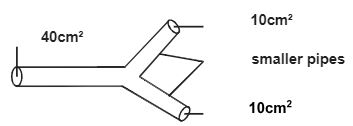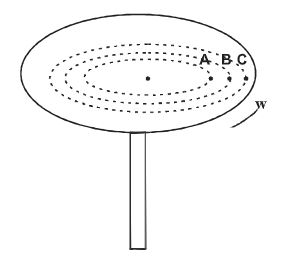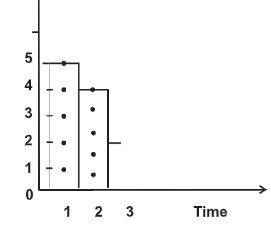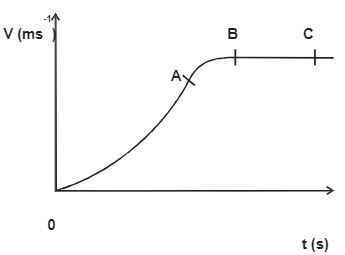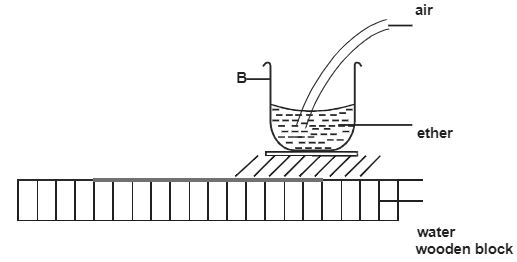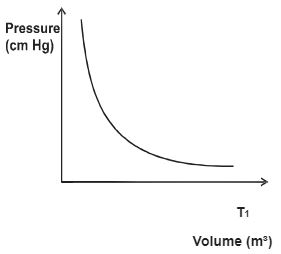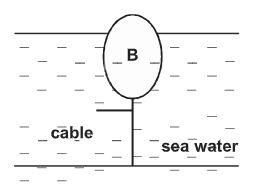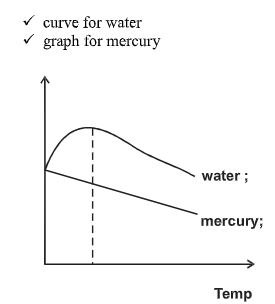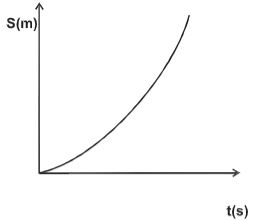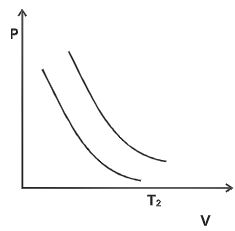INSTRUCTIONS TO CANDIDATES
- This paper consists of two sections; A and B
- Answer all the questions in section A and B
- Non-programmable silent electronic calculators and KNEC mathematical tables may be used.
SECTION A :
- Figure 1 below shows a scale of a Vernier calliper.
- Record the reading indicated. (1 mark)
- Given that the instrument above had a zero error of negative 0.03cm. State the actual reading. (1 mark)
- Figure 2 shows water drops on two surfaces. If the first is smeared with oil while the second is clean.
Explain the difference in the shapes of the drops. (2 marks) - A U-tube manometer is used to measure the pressure of gas in a container as shown below. (The liquid in the manometer is mercury of density 13.6g/cm3)
Find the pressure of the gas in the container. (Take atmospheric pressure as 102,000N/m2 and g = 10N/kg) (3 marks) - Sugar was put in a flask then water was added slowly until it was full then the flask was corked. The figure below shows the observation at the beginning of the experiment and at the end of the experiment.
Account for the empty space. (1 mark) - In an experiment to measure the density of a liquid, a student filled a burette with a liquid to the 0 cm3 mark. The figure below shows a section of burette showing the level of the liquid after 109g of the liquid had been run out.
Determine the density of the liquid. (3 marks) - A uniform metal rod of weight 50N is balanced as shown below.
Find the tension on the string. (3 marks) - On the axis provided plot graphs of density against temperature for water and mercury when they are heated from 0° to 10°C (2 marks)
- The figure below shows a beaker containing ice at 0°C. The beaker is placed on a bench.
State and explain the changes in stability or beaker when ice melts to water. (2 marks) - Define elastic limit. (1 mark)
- Explain why it will feel cooler in a white car than a black one if both of them are left in the sun for a long time. (1 mark)
- The figure below shows a horse pipe of a cross-sectional area of 40cm3.
If the horse pipe is connected to two smaller pipes of cross section 10cm3. Calculate the velocity of water in each of the two pipes.
(3 marks) - The figure shows masses A, B and C. Placed at different points on a rotating table.
State two factors that determine whether a particular mass slides off the table or not. (2 marks)
SECTION B -
- Define acceleration. (1 mark)
- The figure below shows a tape chart from paper tape pulled through a 50Hz ticker timer by a trolley.
Calculate the acceleration of the trolley in cms-2 (3 marks) - The figure below shows a velocity-time graph for the motion of a certain body.
Describe the motion of the body in the region.- OA (1 mark)
- AB (1 mark)
- A particle starts from rest and accelerates uniformly in a straight line. After 4 seconds it is 20m from the starting point. Determine the acceleration of the particle. (3 marks)
- Sketch a displacement-time graph for a body, falling through a fluid. (2 marks)
- Distinguish between elastic and inelastic collision. (1 mark)
-
- State the class of lever to which a fishing rod belongs. (1 mark)
- State two reasons why the efficiency of hydraulic machine cannot be 100%. (2 marks)
- A crane lifts a load through a vertical distance of 8m in 12 seconds.
- Given that the work done by the crane was 96000J. Calculate the amount of load lifted. (2 marks)
- Calculate the power developed by the crane. (2 marks)
- Given that efficiency of the crane was 80% and it was operated using an electric motor. Calculate the rating of the motor. (2 marks)
- The figure below shows how kinetic energy (K.E) at a ball thrown vertically upwards varies with height.
On the same axis, plot a graph of potential energy of the ball. (1 mark) - Sketch a labelled diagram to show how an arrangement of a single pulley may be used to provide velocity ratio of 2. (2 marks)
-
- Akinyi wanted to determine specific heat capacity of iron. She was to use - metal block, thread, water, copper, calorimeter, stirrer, thermometer and cardboard cover, beaker and source of heat. A metal block is dipped in water and water heated to a certain temperature and then transferred to a calorimeter containing some 50 grams of water.
- State two precautions to be taken to minimize heat losses to the surroundings. (2 marks)
- The following figure shows a beaker B placed on a little water on a wooden block and some liquid ether (spirit) then poured into the beaker. Air is now blown into the ether with a foot pump.
It was found after sometime, the water on the wooden block turned into ice. Explain. (3 marks) - A lump of copper of mass 0.75kg is placed in an oven for some time and then transferred quickly to a large block of ice at 0°C. When the temperature of the lump of copper reaches 0°C, 0.45kg of ice is found to have melted. Determine the temperature of the oven. (Take the specific heat capacity of copper as 400J/kg/k and the latent heat of fusion of ice as 3.2 x 105J/kg) (4 marks)
- Give two reason why the actual temperature of the oven may be higher than the above value. (2 marks)
- Akinyi wanted to determine specific heat capacity of iron. She was to use - metal block, thread, water, copper, calorimeter, stirrer, thermometer and cardboard cover, beaker and source of heat. A metal block is dipped in water and water heated to a certain temperature and then transferred to a calorimeter containing some 50 grams of water.
-
- The figure below shows a graph of pressure against volume for a fixed mass of gas at constant temperature.
Sketch on the same axis, a graph for the same mass of gas with a temperature T2 lower than T1. (1 mark) - The figure below shows a simple set up for Boyle’s law apparatus.
Describe how the apparatus may be used to verify Boyle’s law. (5 marks) - The diagram below shows a measuring cylinder with an air bubble at the bottom.
Determine the volume of the air bubble just before the surface of mercury if the atmospheric pressure is 76cmHg and volume of the bubble at the bottom is 10cm3 (3 marks) - Using the kinetic theory of gases. Explain how a rise in the temperature of a gas causes a rise in the pressure of the gas if the volume is kept constant. (3 marks)
- The figure below shows a graph of pressure against volume for a fixed mass of gas at constant temperature.
-
- State Archimedes principle. (1 mark)
- Why is the hydrometer made of:
- wide bulb containing air (1 mark)
- a narrow stem (1 mark)
- A piece of metal weighs 4N in air and 2N when totally immersed in water. Determine the relative density of metal.(Density of water: 1000 kg/m3 (3 marks)
- The figure below shows a buoy B, volume 5m3 and mass 2 tons. It is held in position in sea water of density 1030kg/m3 by a light cable fixed to the bottom so that 3/5 of the volume buoy is below the surface of the sea water. Calculate the tension on the cable. (3 marks)
MARKING SCHEME
SECTION A : (25 Marks)
-
- 4.13cm ✔
- 4.13 − − 0.03 = 4.16cm ✔
-
- Cohesive force is greater than adhesive ✔
- Adhesive force is greater than cohesive ✔
- Patmospheric = Pgas + Pmercury column ✔
102000 = Pg + ( 30 x 13600 x 10); ✔
1000
102000 = Pg + 4080
Pg = 97920 ✔ - Sugar particles occupy the spaces between water molecules after shaking; hence level of water goes down
- Vol = 36.2cm3 ✔
ρ = m
v
ρ = 109g
36.2cm3 ✔
= 3.011g/cm3 ✔ - F1 x di = F2 x d2 ✔
50N x 35m = F2 x 40m
100 100
F2 = 43.75N -
-
- Stability increases ✔
- There is decrease in level of volume, hence lowering the position of c.o.g ✔
- Point beyond which any additional force causes permanent deformation ✔
- Black surfaces are better absorbers of heat than white / shiny hence will feel hotter ✔
-
A1V1 = A2V2 ✔
40 x 30 = 2 x 10 x V2 ✔
V2 = 60m/s ✔ -
- mass ✔
- radius ✔
SECTION B : (55 Marks)
-
- Rate of change of velocity with time ✔
-
u = 5 ✔
5 x 0.02
= 50cms-1 ✔
v = 2 ✔
5 x 0.02
a = v − u
t
a = 20 − 50
(3 - 1)0.02
= 750cms-2 ✔ -
- increasing acceleration with time ✔
- decreasing acceleration with time ✔
- S = ut + ½at2 ✔
20 = 0(4) + ½a(4)2 ✔
20 = 8a
a = 20
8
a = 2.5ms-2 ✔ - In elastic collision kinetic energy is
- In elastic collision kinetic energy is conserved while in elastic colission kinetic energy is not conserved
-
- Third class ✔
-
- Some energy is used to lift the moving parts of the machine ✔
- Energy used to overcome friction in the moving parts ✔
- Lid should be a poor conductor of heat; any two
-
- Work done = force x distance
96000J = 8F
F = 1200N -
P = work done time
P = 96000 ✔ (substitution)
12
P = 8000W or KW - 80% = 8000 x 100% ✔
Pi
80Pi = 800000Pi = 10000W or 10kW ✔
- Work done = force x distance
-
- Heavy lagging of the calorimeter;
- Using a highly polished calorimeter;
- Lid should be a poor conductor of heat any two
- Ether evaporates quickly; ✔ taking its latent heat of evaporation / ✔ vaporisation ✔ from water which then turns into ice ✔
- Heat lost by copper = heat gained by ice ✔
0.75kg x 400J/kgK x (x - 0) ✔
0.45kg x 3.2 x 105J/kg ✔
300x = 144000
x = 480 ✔
-
-
-
Heat is lost while transferring copper to the ice ✔
-
Heat is gained by ice from the surroundings which have temperature higher than 00C ✔
-
-
-
T2 below T1 a curve -
- adjust pressure entering from the pump and note its corresponding length (volume) of enclosed air;
- repeat the experiment, for about five times, and record pressure and it corresponding volume (length) in a table ✔
-
P1V1 = P2V2
(76 + 60)10 = 76V2 or (760 + 600)10 = 760V2
1360 = 76V2 13600 x 10 = 760V2 ✔
V2 = 17.89cm3 V2 = 17.89cm3 ✔ - Temperature raise kinetic energy of molecules ✔ rate of collision of molecules with walls increases ✔ this increases pressure ✔
-
-
- When a body is partially or fully immersed in a fluid, it experiences an upthrust equal to the weight of the fluid displaced ✔
-
- To displace large volume of liquid for sufficient upthrust, to keep the hydrometer floating ✔
- Increase its sensitivity ✔
- R.D = weight of metal
upthrust in water ✔
= 4N ✔
2N
= 2 ✔ - upthrust = 3/5 x 5 x 1030 x 10
= 30900N ✔
T = U - W
T = 30900 - 20000 ✔
T = 10900 N ✔
Download Physics Paper 1 Questions and Answers - Lanjet Joint Mock Exams 2023.
Tap Here to Download for 50/-
Get on WhatsApp for 50/-
Why download?
- ✔ To read offline at any time.
- ✔ To Print at your convenience
- ✔ Share Easily with Friends / Students




